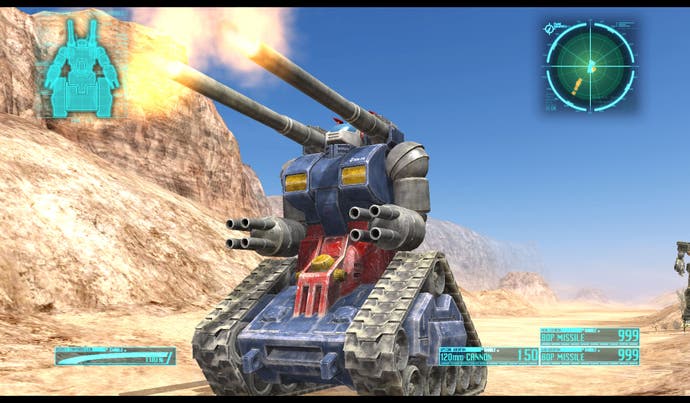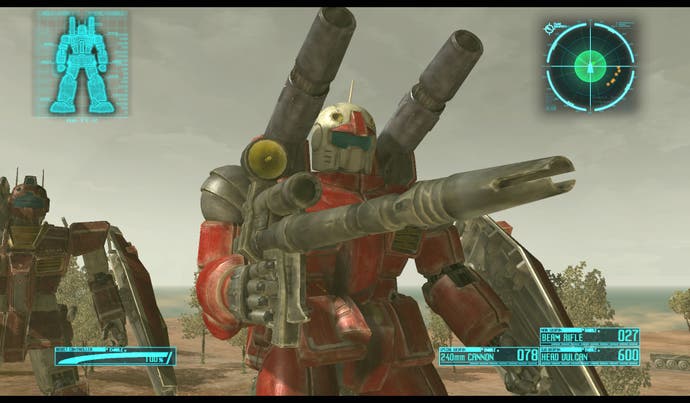Mobile Suit Gundam: Target in Sight
What to mech of this?
Writing this review was going to be very straightforward. The opening of Target in Sight (known as Crossfire in the US) creates such a bewilderingly bad impression that the game seems to be a cruel joke at the expense of ardently loyal Gundam fans across the globe. Reviewing the game would simply involve checking out a few later missions to confirm that it is indeed one of the worst games ever made, perhaps while doing something more interesting, like reading a book or playing on the DS. Then it would be a simple matter of bashing out an extended warning to Eurogamer readers not to even think about thinking about playing it.
Here's what happens at the start of the game: First, you choose sides, between the Zeon (the rebellious space colonists) and Earth Federation (ostensibly the good guys). Then there's a succession of sepia-toned still images accompanied by a histrionic voiceover outlining the background to The One Year War (the first major conflict in the original Gundam storyline, before the series span off into about a million alternate universes). So far, so good. Then the camera pans across the horizon, s-l-o-w-l-y with juddering framerate, to alight upon a quite beautifully depicted, battle-worn mobile suit (which is what the big robots are called in the Gundam universe). So far, so neutral. Then you try to move that beautifully-battle-worn mobile suit and it clunks into gear. Again: s-l-o-w-l-y. And here's where the problems really start.

You try to move across the battlefield (jungle for Zeon forces, rubble-strewn desert if you choose to play as Federation). Confused by your suit's slothful pace, you test out your jetpack. This seems to bring your mobile suit to a momentary halt before it fires up for about a second, depositing the mobile suit not very far. Deciding to continue on foot, you try to change direction, only to find that this also seems to confuse your mobile suit into a momentary standstill. Soon it's time to shoot at your half-witted enemies, but your equally half-witted mobile suit again takes a leisurely pause before taking aim. So you shoot the enemy mobile suits for what feels like a (universal) century before they finally enter their death throes (which shock you out of your slack-jawed confusion because the limbless flailing actually looks pretty good).
Then you run out of bullets. It's okay though: you can fall back on your melee weapon. Except at this point it's hardly surprising that there's a long delay between hitting the melee attack button and your mobile suit performing a melee attack. And finally, in case you weren't perplexed by how such cutting-edge console technology could be home to such a miscarriage of design, enemy reinforcements arrive and shoot you in the back, or sneak past into your base, forcing you to do it all again. It's just a confusingly unresponsive mess, which, in spite of some glaring signs of technical mediocrity, apparently pushes the PlayStation 3 so far that a decent framerate is beyond it. It is possible to install the game to your hard drive, though this doesn't produce any noticeable improvement. It's like playing Federation vs. Zeon on the PS2 underwater.

Here's what happens for the rest of the game: between missions you navigate a series of text menus to repair and upgrade your mobile suit, and requisition more mobile suits and pilots to assist you. Each turn represents one day of The One Year War, which you enter, as the commander of a battalion of experimental mobile suit prototypes, nine months in (which means that the course of the game runs for three months). Occasionally, missions will become available to play, until they become unavailable again on a certain date, in different theatres of war that gradually open up over the course of the game.
Choosing not to play these missions has no repercussions, but if you do choose to enter the fray you'll be able to bring along up to two sidekicks to help you in what's a normally a fairly standard destroy-everything, defend-something type of sortie. Completing missions grants you more resources with which to access new Mobile Suits and upgrades, such as improved weapons, enhanced defence, or mobile suits that are tailored to a particular environment (such as Jungle, or Marine). It also allows you to level up, enhancing your own statistics and granting the ability to order other pilots round on the battlefield (although one of the game's niggles is that the other pilots don't acknowledge your orders).

And then something strange happens. Somewhere along the line, in spite of everything, you find yourself perversely enjoying being in charge of a big ponderous robot, destroying everything or defending something. You begin to master the underwater sense of timing and to appreciate the tactical nuances of the slow game speed (after all, enemy mobile suits are just as slow and cumbersome as yours, and you soon learn to time your movement and attacks to take advantage). You begin to master the consequences of finite ammunition (again, adding a strategic dimension to battle - particularly when supply points are present on the battlefield). And it begins to actually feel like you've gained mastery over your big, ponderous robot. Sure, it's not as quick or smooth as previous Gundam games (or just about any other third-person shoot-'em-up for that matter), but it totally captures the essence of a pseudo-realistic interpretation of the Gundam universe.
So actually this turned out to be a pretty difficult review to write, and certainly a difficult game to score, because it raises very thorny philosophical questions about the art of reviewing. Is it possible to ever rate a game objectively? Objectively this is a game that basically sucks. It's technically limited, characterised by treacle-slow, far-from-original gameplay that's beset by niggles, and sorely unadorned by fancy cut-scenes or easy-to-navigate menus. But subjectively, in spite of all of its flaws, what emerges is something that has the potential to be hypnotically absorbing and, yes, even fun. Something that captures the feel of being thrust into the gritty, unglamorous, blunt end of a globe-spanning conflict in a giant robot that sometimes runs out of bullets. Perhaps the best solution, then, is a compromise between objectivity and subjectivity.
